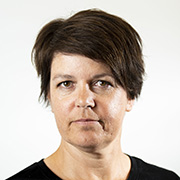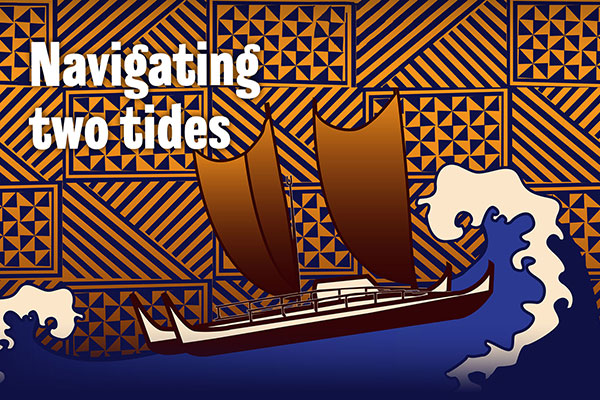
Asian immigration in the 80s and 90s stoked old fears of the “Asian invasion” and fuelled racism. Chinese were blamed for increasing house prices, monopolising good grades at schools and driving terribly. But despite the rich Asian stereotype many Chinese at that time arrived with little financially.
Reporter Sally Kidson, Braden Fastier and Virginia Woolf explore how these Asian immigrants created better lives for their families against a backdrop of intolerance.
Made with support from

Nancy Jiang bounds across the rough alpine terrain as lightly as a dancer.
And man is she fast.
Look away and she’s gone, only to pop up seconds later far ahead of where you expected she would be.
The fiercely determined Jiang represents New Zealand in mountain and trail running.

She wears out her size 6.5 running shoes every three months and sometimes commutes to work via the steep Nelson hills.
Jiang started running at primary school. A teacher encouraged the structural engineer to enter the inter-school cross country. And the rest, she says, “is history”.
To her traditional Chinese parents and grandparents' unease, Jiang excelled at running. She also loved it.
They tried to discourage her by telling her “Chinese people don’t run”. They also limited the time she could spend outside.
Wanting her to succeed, they pushed her to study Mandarin and calculus at the weekend.
It only made Jiang more resolute.
When I got told Chinese don't run, and we're not going to be good at it … I think I decided I was going to prove my parents and family wrong. And that I was going to represent New Zealand one day,” she laughs.
Jiang is the current NZ mountain running champion. Ultra-marathons are her passion.

When Nancy Jiang’s family told her Chinese don’t run, she was determined to prove them wrong.
When Nancy Jiang’s family told her Chinese don’t run, she was determined to prove them wrong.
Her parents, Linda and Leiming, shifted to New Zealand from Ma'anshan, China when Jiang was five. Her younger sister Lucy was born in Aotearoa.
She remembers her parents selling everything, including her toys, to come to New Zealand in search of a better life.
“Everything was quite restricted in China. They were basically told what job they could do after they finished university.”

Nancy Jiang with her mother Linda and sister Lucy.
Nancy Jiang with her mother Linda and sister Lucy.
Asian immigrants at the time Jiang’s parents migrated were often seen as rich and flashy. The stereotypical Asian drove expensive cars and snapped up ostentatious houses in Auckland.
But, Jiang’s family, like other migrants from China in the 90s, had to work hard, hustle and build an existence from scratch.
The Jiangs lived with another Chinese family in a state house in the Auckland suburb of Glen Innes for their first year.
It was a rough area. An image “imprinted” in Jiang’s mind is of the neighbourhood kids picking the bones of left-over food clean at her house.

Nancy Jiang making dumplings with her mother Linda.
Nancy Jiang making dumplings with her mother Linda.
Her parents worked hard, and lived frugally.
“When they were growing up food was scarce because of the whole communist regime. I know some of my relatives died from starvation during the communist era.”
Jiang laughs often, and has a wide smile that accentuates her dimples. She is softly spoken, and gracious. But her strength of character and steely determination is obvious.
She hints at experiencing racism growing up, but it is not something she dwells on.
She played “a lot of sport” at school and that “helped me fit in”.
Jiang is adamant she hasn’t set out to smash stereotypes in her sport; she is just “super head-strong”.
“I like to prove people wrong. If you tell me I can’t do something. I’m going to go ahead and prove you otherwise.”
While she pushed back against her parents growing up, she now understands their rationale.
Running for fun was foreign to her parents raised in impoverished Communist China.
“They were worried that it was going to affect my health and my growth.
“I think they wanted to make sure I got good grades, got into university, did well and got a job that was financially stable.”
While she hasn’t had anyone in New Zealand question her citizenship - she has overseas.

One memorable moment was during a race at 3000m in France.
“Even though it's a New Zealand singlet, some of the people there were like ‘go China’. I didn't have enough breath to correct them.”
She also wants her story to encourage others to forge their own paths.
“Hopefully some other little Chinese girl will see this and be inspired.”
Auckland academic Manying Ip says before 1987 New Zealand’s immigration policy strongly favoured immigrants from Europe - mainly Britain and Ireland.
All this changed in 1987 when Aotearoa’s “white” immigration framework was replaced with a system based on the personal qualities of immigrants.
Migrants who now met educational, business, professional, age or wealth requirements could apply to New Zealand regardless of their race or nationality.
Immigrants who were young and educated were actively sought to build the New Zealand economy which was “cutting its apron strings” with Britain.
This really was for the first time ever that people who were non-British could come into the country in any sizable number.
Young adventurous Asians, particularly from Hong Kong, Taiwan, Korea, Singapore and China took a punt on New Zealand.
Ip says they were attracted to Aotearoa in the late 80s and 90s for a number of reasons.

They wanted to make a better life, to educate their children in a less competitive environment, to experience a western democracy and for the Chinese there was a fear of the Chinese Communist Party.
This led to a huge increase in the number of Asians living in New Zealand.
From 1986 to 2006 New Zealand’s Chinese population grew from 26,541 to 147,567 - an increase of 456 per cent.
Fears of the country being overrun with Asians - first aired in the 1860s - resurfaced.
Reports of racist attacks were published in newspapers, and the media itself was guilty of stoking anti-Asian sentiment.
Winston Peters, and the New Zealand First Party, campaigned on anti-immigration in 1996 on what has been widely called a thinly veiled anti-Asian platform.
In 2004 Peters said the country was “being dragged into the status of an Asian colony and it is time that New Zealanders were placed first.”
Rose Lu arrives in a burst of colour instantly brightening an already beautiful autumnal Wellington afternoon.
The software engineer and writer turns up on her road bike. She doesn’t drive.
Her red helmet contrasts with her waist-long black hair.

Wearing an African-print pink jumpsuit, lime sneakers and hexagonal glasses she isn’t afraid to stand out in button-downed Thorndon.
Lu, who studied mechatronics engineering and also has a masters in creative writing, has a six month grant to live at historic Randell Cottage to write her first novel.
The book, she says, will explore the uncharted topic of Chinese women in the New Zealand outdoors.
I wanted to write about Chinese women in the outdoors, because you know, it's not something you ever see really.
Lu, who loves tramping, climbing and the outdoors has glibly described her future novel as “Brokeback Mountain but in the Tararua Ranges”.
Her first book - All Who Live on Islands - is a series of personal essays exploring growing up as a minority in regional New Zealand.

Her 20s was a time of coming to terms with her cultural identity and exploring where she fitted between China and New Zealand.
She wrote All who Live on Islands after searching for New Zealand stories similar to hers and discovering there was “nothing”.
Like Jiang, Lu's parents also grasped the opportunity to build a better life in New Zealand.
China as a country was just so incredibly poor at that point in time.
Her family moved from Shanghai to Auckland armed with a middle class background and just $6000 in the mid 90s. Part of the $6000 was stitched into the coat Rose wore into the country.
“I was the cash mule,” she jokes.
Her dad was 30. Lu was 5. Her brother was born in New Zealand.
The family moved to Whanganui when Rose was in Year 9. Moving away from the culturally diverse Mt Roskill was a shock.
“My entire, like, peer group [In Auckland] were Chinese or Indian, and it felt really normal.
“And then when I moved to Whanganui, which I think it's maybe 33 per cent Māori, and then the rest … Pākeha and other.”
(Nearly 70 per cent of the 247,770 people who identify as Chinese live in Auckland, the 2018 census shows.)
The lack of other Asian families in Whanganui meant she keenly experienced being different in a small town which meant “lots of jokes” and put downs.
At times it felt “really, really unfair”.

Lu smiles often, drops the f-bomb and explains tricky topics simply. She’s sassy, and says that despite the racism “didn’t put up with any shit”.
“I'm like … well, if you want to dish it out … you better take it back from me, you know.”
Lu also saw her mother and father work long hours in the dairy and takeaway to build a life from the ground up.
“It's so hard to start your life from scratch. And that's kind of what I saw my parents do.”
Her father had a degree in engineering, and did a masters at Massey University, but instead chose the well worn migrant path of running a diary and take-away shop.
Now 31, Rose is comfortable having a foot in two cultures. An extended period in China helped her gain a deeper understanding of that part of her whakapapa.
I felt, finally, my version of being Chinese was kind of valid as well because there is no way to be Chinese … if you are Chinese, you are just Chinese, so you don't have to be a certain way.

Appo Hocton, November 1876. Nelson Provincial Museum, W E Brown Collection: 13043
Appo Hocton, November 1876. Nelson Provincial Museum, W E Brown Collection: 13043
The first Chinese to arrive in New Zealand was Appo Hocton who jumped ship in Nelson in 1842, but the Chinese arrived in significant numbers on the Otago Goldfields.
They were invited to re-work the gold fields in 1865, and numbered about 4000 at their peak in 1871.
As the gold ran out, from the 1890s onwards, the men moved into other regions to work in market gardens, fruit and veg shops and laundries.
The Chinese faced discrimination, such as an entry or poll tax - “For no other reason than for the fact they were Chinese,” Ip says.
Other laws singled out the Chinese such as a cargo tax limiting the numbers of Chinese that could enter, a reading test upon arrival, and being deprived of their right to naturalisation from 1908 to 1951.
Women and families were finally allowed to settle in New Zealand as refugees on the back of China’s efforts in WW2.
But by 1986 Chinese were still only 1 per cent of New Zealand’s population.
In 2002 Helen Clark’s government apologised for the poll tax, which started at 10 pounds and increased to about a year’s wages, or 100 pounds. The tax was abolished in 1944.
Ip says the arrival of immigrants from diverse parts of China in the 80s and 90s transformed the make-up of the NZ Chinese population.
Cantonese is no longer the main language spoken, Mandarin now is.
The old Chinese were from Guangdong in southern China. They were from humble farming backgrounds, largely uneducated and built a life in New Zealand by “keeping their heads down”.
In contrast to earlier immigration the men from newer immigrant whānau left families in New Zealand to work in the booming Asian economies.
The new arrivals were also more likely to speak out and challenge racism, Ip says.
Ip says Kiwis in the 80s and earlier were generally ignorant of Asia. Many couldn’t distinguish between different Asian countries let alone new or old immigrants.
The old Chinese, who had worked hard to integrate in New Zealand, suddenly found themselves experiencing racism and resented the new arrivals for sticking out.
For her part Ip says New Zealand was not prepared to deal with new immigrants in the 80s and 90s.
She still remembers teachers, officials and others who were genuinely puzzled why migrants picked due to their successful backgrounds were floundering in New Zealand.
“Everyone was taken by surprise.”
Part of the reason it was so difficult was the Kiwi business environment was so foreign.

Chinese immigration changed the face of some parts of Auckland causing old racism towards Asians to resurface.
Chinese immigration changed the face of some parts of Auckland causing old racism towards Asians to resurface.
She recalls suggesting to a migrant they could set up a shop in busy parts of downtown Auckland such as Newmarket - and the immigrants said there was “hardly any foot traffic”.
Friends who worked in international banks confided that the transactions they did in one day in Asia would be the equivalent of one month’s transactions in NZ.
The tall poppy syndrome in New Zealand meant new Asians who drove their new Mercedes or BMW were genuinely not aware they would be seen as showing off.
The new Chinese really stuck out like a sore thumb.
Despite the racism Chinese have faced, Ip is optimistic about the future.
She’s excited to hear about Jiang and Lu and says more New Zealand Chinese role models are needed.
By telling the stories of New Zealand Chinese and the discrimination they have suffered will help bring change, she says.
Ip strongly advocated for the history of New Zealand Chinese to be included in the new school curriculum, despite being told they did not want to “focus on newcomers”.
“And I said; ‘180 years [of Chinese immigration] is a pretty long time’.”
Projects like this take time and resources. Please become a Stuff supporter and help enable this type of work.
Getting to the truth takes patience and perseverance. Our reporters will spend days combing through documents, weeks cultivating delicate sources, and months – if not years – fighting through the Official Information Act, courts and red tape to deliver their stories.
By supporting Stuff you'll help our journalists keep the pressure on. Make a contribution from as little as $1 today.










